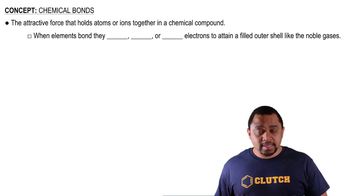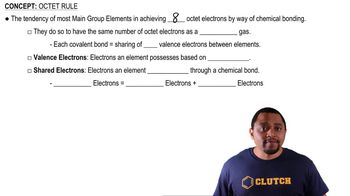Which of the following charts shows the general periodic trends for the electronegativities of the representative elements? [Section 8.4]
Fill in the blank with the appropriate numbers for both electrons and bonds (considering that single bonds are counted as one, double bonds as two, and triple bonds as three). (a) Fluorine has _ valence electrons and makes _ bond(s) in compounds. (b) Oxygen has _ valence electrons and makes _ bond(s) in compounds. (c) Nitrogen has _ valence electrons and makes _ bond(s) in compounds. (d) Carbon has _ valence electrons and makes _ bond(s) in compounds.
 Verified step by step guidance
Verified step by step guidanceKey Concepts
Valence Electrons

Types of Chemical Bonds

Octet Rule

A molecule with formula C4H3NO has the connectivity shown in the figure. After the Lewis structure of the molecule is completed, how many of each of the following are there in the molecule:
a. single bonds,
b. double bonds,
c. triple bonds,
d. nonbonding pairs? [Sections 8.3 and 8.5]
In the Lewis structure shown here, A, D, E, Q, X, and Z represent elements in the first two rows of the periodic table. Identify all six elements so that the formal charges of all atoms are zero.
The molecule shown here is styrene, C8H8, a benzene derivative that is used to make a number of polymers, including polystyrene. The shorthand notation for the benzene ring (described in Section 8.6) is used. Three of the carbon–carbon bonds are numbered in the structure.
a. Which of the three bonds is the strongest?
b. Which of the three bonds is the longest?
c. Which of the three bonds is best described as halfway between a single and a double bond? [Sections 8.6 and 8.8]
Consider the Lewis structure for the polyatomic oxyanion shown here, where X is an element from the third period (Na - Ar). By changing the overall charge, n, from 1- to 2- to 3- we get three different polyatomic ions. For each of these ions (b) determine the formal charge of the central atom, X;
(a) True or false: An element's number of valence electrons is the same as its atomic number.
